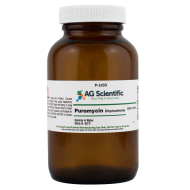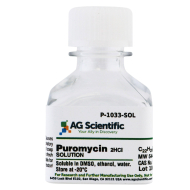Puromycin is an aminonucleosidic antibiotic. Puromycin is a protein synthesis inhibitor by inhibiting translation. Puromycin's main function is used in cell biology as a selective antibiotic agent in cell culture systems.
 Puromycin
Puromycin is an aminonucleosidic antibiotic and acts as a protein synthesis inhibitor by inhibiting translation. It is primarily used in cell biology as a selective antibiotic agent in cell culture systems. Puromycin is also used for selecting mammalian cell lines, which have been transformed by vectors that express puromycin-N-acetyl-transferase (PAC). It is toxic to prokaryotic and eukaryotic cells. Puromycin is derived from the
Streptomyces alboniger bacterium. Attached are 9 tips influencing successful gene transfection.
1. Concentration and purity of nucleic acids
Determine the concentration of your DNA using 260 nm absorbance. Avoid cytotoxic effects by using pure preparations of nucleic acid.
2. Cells can escape selection
If the antibiotic is used at too low concentration.
3. Cells can also escape selection
If cell density on the plate is too high.
4. Cells rapidly proliferating
are killed faster than these, only slowly proliferating. Control cells should die within 5-7 days after addition of the antibiotic allowing colonies of resistant cells to form by 10-14 days.
5. Transfection in serum-free media
The highest transfection efficiencies can be obtained if the cells are exposed to the transfection complexes in serum-free conditions followed by the addition of medium containing twice the amount of normal serum to the complex medium 3-5 hours post-transfection (leaving the complexes on the cells). However, the transfection medium can be replaced with normal growth medium if high toxicity is observed.
6. Media
Minimally media should be changed out every 2-3 days.
7. No antibiotics in transfection medium
The presence of antibiotics can adversely affect the transfection efficiency and lead to increased toxicity levels in some cell types. It is recommended that these additives be initially excluded until optimized conditions are achieved, then these components can be added, and the cells can be monitored for any changes in the transfection results.
8. High protein expression levels
Some proteins when expressed at high levels can by cytotoxic; this effect can also be cell line specific.
9. Cell history, density, and passage number
It is very important to use healthy cells that are regularly passaged and in growth phase. The highest transfection efficiencies are achieved if cells are plated the day before. However, ensure adequate time should be allowed to allow the cells to recover from the passaging (generally >12 hours). Plate cells at a consistent density to minimize experimental variation. If transfection efficiencies are low or reduction occurs over time, thawing a new batch of cells or using cells with a lower passage number may improve the results.


